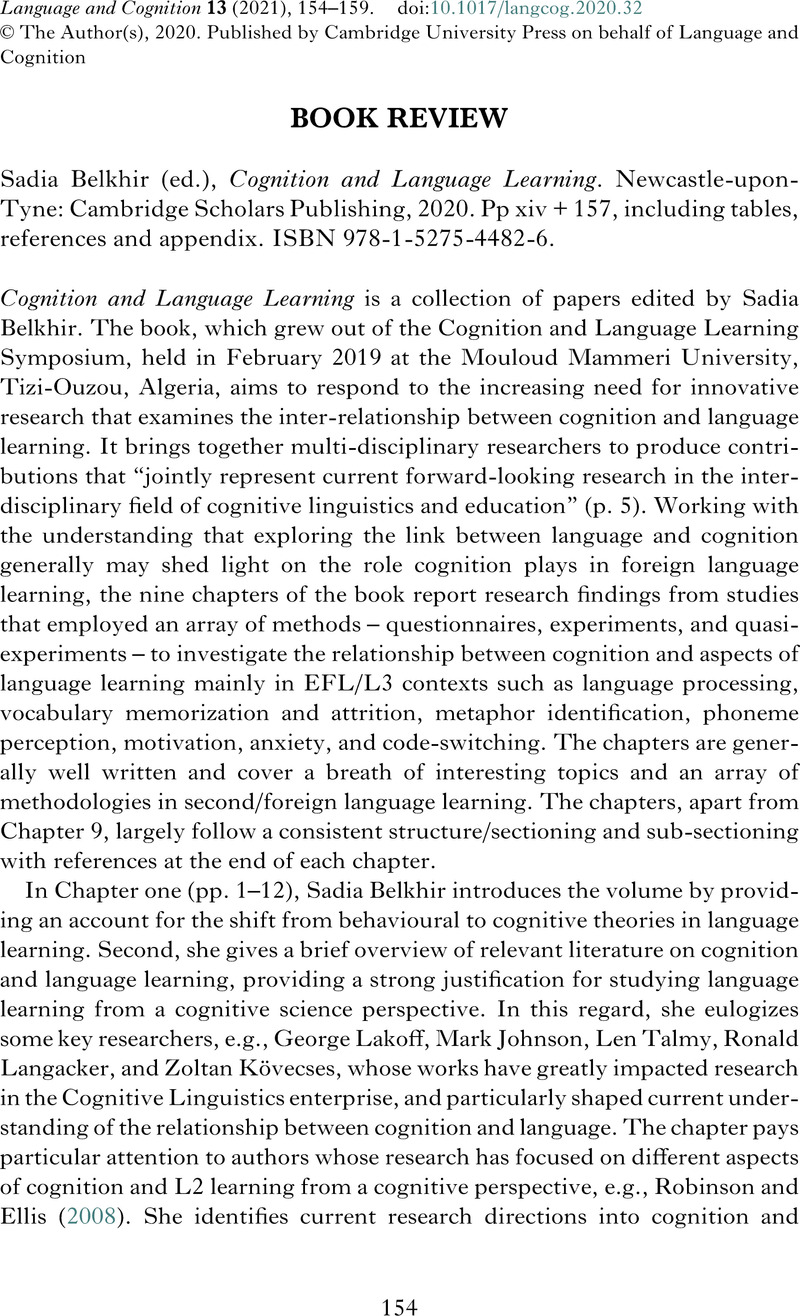No CrossRef data available.
Article contents
Sadia Belkhir (ed.), Cognition and Language Learning. Newcastle-upon-Tyne: Cambridge Scholars Publishing, 2020. Pp xiv + 157, including tables, references and appendix. ISBN 978-1-5275-4482-6.
Review products
Sadia Belkhir (ed.), Cognition and Language Learning. Newcastle-upon-Tyne: Cambridge Scholars Publishing, 2020. Pp xiv + 157, including tables, references and appendix. ISBN 978-1-5275-4482-6.
Published online by Cambridge University Press: 16 November 2020
Abstract
An abstract is not available for this content so a preview has been provided. Please use the Get access link above for information on how to access this content.

- Type
- Book Review
- Information
- Copyright
- © The Author(s), 2020. Published by Cambridge University Press on behalf of Language and Cognition
References
references
Ansah, G. N. (2014). Culture in embodied cognition: metaphorical/metonymic conceptualizations of FEAR in Akan and English. Metaphor and Symbol 29(1), 44–58.CrossRefGoogle Scholar
Block, E. L. (1992). See how they read: comprehension monitoring of L1 and L2 readers. TESOL Quarterly 26(2), 319–343.CrossRefGoogle Scholar
Flege, J. E. (1995). Second language speech learning: theory, findings, and problems. In Strange, W. (ed.), Speech Perception and Linguistic Experience: Issues in Cross-language Research 92 (pp. 233–277). Timonium, MD: York Press.Google Scholar
Flege, J. E. & MacKay, I. R. (2004). Perceiving vowels in a second language. Studies in Second Language Acquisition 26(1), 1–34.CrossRefGoogle Scholar
Gardner, R. C. & Lambert, W. E. (1972). Attitudes and Motivation in Second-Language Learning. Rowley, MA: Newbury House.Google Scholar
Grimaldi, M., Sisinni, B., Gili Fivela, B., Invitto, S., Resta, D., Alku, P. & Brattico, E. (2014). Assimilation of L2 vowels to L1 phonemes governs L2 learning in adulthood: a behavioral and ERP study. Frontiers in Human Neuroscience 8, e2014.00279.CrossRefGoogle ScholarPubMed
Group, P. (2007). MIP: a method for identifying metaphorically used words in discourse. Metaphor and Symbol 22(1), 1–39.CrossRefGoogle Scholar
Kachru, B. B. (1985). Standards, codification and sociolinguistic realism: the English language in the outer circle. In Quirk, R. & Widdowson, H. G. (eds), English in the world: teaching and learning the language and literatures (pp. 11–30). Cambridge: Cambridge University Press.Google Scholar
Kövecses, Z. (2004). Introduction: cultural variation in metaphor. European Journal of English Studies 8(3), 263–274.CrossRefGoogle Scholar
Kövecses, Z. (2005). Metaphor in Culture: Universality and Variation. Cambridge: Cambridge University Press.CrossRefGoogle Scholar
Krashen, S. (1982). Principles and practice in second language acquisition. Oxford: Pergamon.Google Scholar
Lantolf, J. P. (1994). Sociocultural theory and second language learning: introduction to the special issue. Modern Language Journal 78(4), 418–420.CrossRefGoogle Scholar
Maalej, Z. (1999). Metaphor making and processing. Journal of Literary Semantics 28, 105–123.CrossRefGoogle Scholar
Pavlenko, A. (2007). Emotions and Multilingualism. Cambridge: Cambridge University Press.Google Scholar
Robinson, P. & Ellis, N. C. (eds) (2008). Handbook of Cognitive Linguistics and Second Language Acquisition. New York and London: Routledge.CrossRefGoogle Scholar
Sharifian, F. (ed.) (2014). The Routledge Handbook of Language and Culture. London and New York: Routledge.CrossRefGoogle Scholar
Sheorey, R. & Mokhtari, K. (2001). Coping with academic materials: differences in the reading strategies of native and non-native readers. System 29(4), 431–449.CrossRefGoogle Scholar
Tomasello, M. (2009). Constructing a Language. Cambridge, MA: Harvard University Press.Google Scholar



